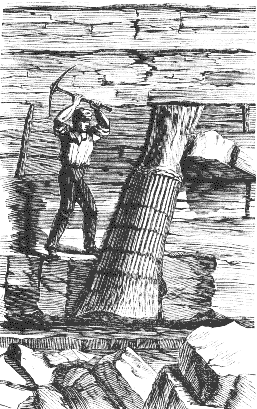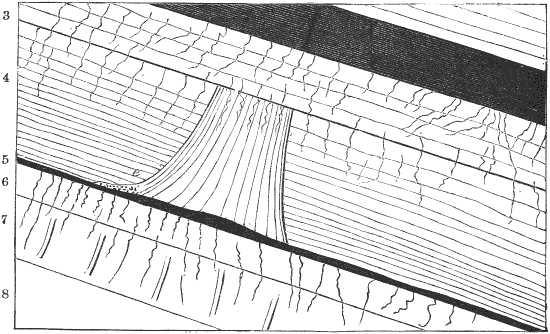
"Polystrate" Tree Fossils
Copyright © 1994-1997 by
Andrew MacRae
![]()

"Polystrate" Tree Fossils
Copyright © 1994-1997 by
Andrew MacRae
![]()
 ome
creationist presentations include claims about "polystrate fossils".
From the description, this term is used for fossils which intersect several
beds (layers), usually in sedimentary rocks. Although often used in
creationist literature, I have been unable to determine the origin of the
term -- it is not a standard geological term. This makes it difficult
for the uninitiated to find conventional literature about these fossils.
This presentation attempts to explain what "polystrate fossils" are, and
offers a critique of claims made about them. If you have any questions,
feel free to contact the author via e-mail. I have seen plenty of
examples of "polystrate" fossils in the field.
ome
creationist presentations include claims about "polystrate fossils".
From the description, this term is used for fossils which intersect several
beds (layers), usually in sedimentary rocks. Although often used in
creationist literature, I have been unable to determine the origin of the
term -- it is not a standard geological term. This makes it difficult
for the uninitiated to find conventional literature about these fossils.
This presentation attempts to explain what "polystrate fossils" are, and
offers a critique of claims made about them. If you have any questions,
feel free to contact the author via e-mail. I have seen plenty of
examples of "polystrate" fossils in the field.
Are "polystrate" fossils a problem for conventional geology?
Well, they were not a problem to explain in the 19th century, and are still not a problem now. John William Dawson (1868) described a classic Carboniferous-age locality at Joggins, Nova Scotia, where there are upright giant lycopod trees up to a few metres tall preserved mainly in river-deposited sandstones. These trees have extensive root systems with rootlets that penetrate into the underlying sediment, which is either a coal seam (i.e. compressed plant material), or an intensely-rooted sandstone or mudstone (i.e. a soil horizon). Dawson considered and rejected anything but an in situ formation for these fossils, and his interpretation is closely similar to current interpretations of sediments deposited on river floodplains. An interesting feature of these examples is the presence of vertebrate fossils (mostly small reptiles) within the infilling of the stumps.
The reason I am using Dawson rather than a more recent reference is to emphasize that many supposed "problems" with conventional geology were solved more than 100 years ago using very basic principles. The people suggesting these "problems" exist are so out of date that even 19th-century literature refutes their presentations.

An upright tree preserved in the cliffs at Joggins, Nova Scotia. Figure 35 of Dawson [1]. |

Stratigraphy in association with an upright tree stump, Joggins, Nova Scotia. Figure 41 of Dawson [1] Original Caption: "1.=Shale. 2.=Shaly coal, 1 foot. 3. Underclay with rootlets, 1 foot 2 inches. 4. Gray sandstone passing downwards into shale, 3 feet. Erect tree with Stigmaria roots (e) on the coal. 5. Coal, 1 inch. 6. Underclay with roots, 10 inches. 7. Gray sandstone, 1 foot 5 inches. Stigmaria rootlet continued from the bed above; erect Calamites. 8. Gray shale, with pyrites. Flattened plants." |
The following is a more detailed post on polystrate fossil trees I presented previously in talk.origins:
|
In article <1994May22.133828.562@alc-ohio.alc.com>
malone@alc-ohio.alc.com (Bruce Malone) writes:
"[...] One of the best, and longest-known "fossil forest" occurrences is a locality known as Joggins, in Nova Scotia. It is Carboniferous in age, and was first described in detail in the late 1800s. Here is a quote from Dawson 1868 (pp. 179-180) on the nature of the trees at this locality, in a beautiful cliff section over 1km thick: "In the [stratigraphic] section in the preceding chapter, the reader will observe the words 'Underclay, Stigmaria [a type of fossil tree trunk]' frequently recurring; and over nearly every underclay is a seam of coal. An underclay is technically the bed of clay which underlies a coal-seam; but it has now become a general term for a fossil soil [Dawson's emphasis], or a bed which once formed a terrestrial surface, and supported trees and other plants; because we generally find these coal underclays, like the subsoils of many modern peat-bogs, to contain roots and trunks of trees which aided in the accumulation of the vegetable matter of the coal. The underclays in question are accordingly penetrated by innumerable long rootlets, now in a coaly state, but retaining enough of their form to enable us to recognize them as belonging to a peculiar root, the Stigmaria, of very frequent occurrence in the coal measures, and at one time supposed to have been a swamp plant of anomalous form, but now known to have belonged to an equally singular tree, the Sigillaria, found in the same deposits (Fig. 30). The Stigmaria has derived its name from the regularly arranged pits or spots left by its rootlets, which proceeded from it on all sides. The Sigillaria has been named from the rows of leaf-scars which extend up its trunk, which in some species is curiously ribbed or fluted. One of the most remarkable peculiarities of the stigmaria-rooted trees was the very regular arrangement of their roots, which are four at their departure from the trunk, and divide at equal distances successively into eight, sixteen, and thirty-two branches, each giving off, on all sides, an immense number of rootlets, stretching into the beds around, in a manner which shows that these must have been soft sand and mud at the time these roots and rootlets spread through them. There is very little, with the exception of terminology, that would be different in a "modern" interpretation of these features, and Dawson has much more detail on the other sedimentological features found at Joggins that support his interpretation. Dawson records well over a dozen horizons with large upright trees, and smaller ones are even more common. The section at Joggins can still be visited today, and is particularly well-known for the small reptile fossils found there (they often occur inside the upright tree stumps, apparently they fell in the hollow stump). There are usually a few upright trees exposed on the shore, although the rapid erosion of the 10m+ high cliffs means the exposed examples change every year. Given that an "in place" occurrence was convincingly determined by observations made in the 19th century for this and many other "fossil forest" localities, it is surprising that these conclusions have not been recognized by modern "young Earth global flood" [YEGF] creationists as clear evidence of non-global-flood deposition for much of the geologic record. They often hinge their current arguments on the occurrence of upright trees in Yellowstone National Park, point to their volcanic setting, and then point to floating upright trees floating in Spirit Lake near Mt. St. Helens [2], and say, "See? They could be transported during the flood.". This argument is completely fallacious, because most "fossil forests" do not occur in volcanic deposits, and do have the fragile roots of the stumps tightly penetrating into the surrounding sediment, often into a paleosol (fossil soil) [besides Joggins, see also 3]. One occurrence is even associated with dinosaur footprints on the same surface, on top of a coal seam [4, 5, 6]. The "transported floating upright stumps" model [2] is a complete red herring that does not apply to the vast majority of "fossil forest" occurrences. As for Malone's "problem" with the "thousands of years" for the tree to remain upright for "slow accumulation" to occur, it is a non-problem - he is simply interpolating the average depositional rates for an entire formation down to the scale of metres. This is not the correct way to do it, because individual beds can be deposited rapidly (say, sands and mud during a levee breach), and then little deposition can occur for a long time (e.g., a soil horizon), as is observed in modern river floodplain environments where trees commonly occur. In short, he is assuming conventional geologists would interpret the occurrence the simple way he has interpolated - they do not. One of the most compelling features of Dawson's comments, from a YEGF creationist's perspective, may be the closing remarks of his book, in the conclusion section on p.671. Statements expressing similar sentiments can be found in most geological books of the period (e.g., Murchison's "Siluria", where the Silurian and other Paleozoic systems are first defined):
"Patient observation and thought may enable us in time better to comprehend these mysteries; and I think we may be much aided in this by cultivating an acquaintance with the Maker and Ruler of the machine as well as with His work." Dawson has no theological problems with the conclusions he drew, which are basically similar to the ones drawn by geologists now. Many other geologists of the period were devoutly religious, and clearly expressed the fact in their publications. Apparently, many 19th century geologists share a common philosophical framework with modern creationists, but, strangely enough, modern creationists come to completely different conclusions from both the 19th century geologists and current geologists. The common appeal by modern creationists to an "atheistic" or "humanistic" philosophical framework that "taints" the interpretations of science is quite ridiculous in light of the strong beliefs of many historical scientists, particularly in geology. Why should creationists still have a problem with their conclusions, more than 100 years later? Malone, along with many "young Earth global flood creationists", have no idea that even data from the 19th century, presented by a creationist geologist is enough to demolish the "polystrate fossil trees" part of their presentation. "Polystrate fossil trees" are probably one of the weakest pieces of evidence YEGF creationists can offer for their interpretation. I wish they would stop using it. |
Related Material
Here is some information on the occurrence of fossil trees in Yellowstone National Park.
The occurrence of a "fossil whale standing on its tail" from Lompoc, California is a classic. This is an article by Darby South.
See the following information on the formation of coal.
References
[1] Dawson, J.W., 1868. Acadian Geology. The Geological Structure, Organic Remains, and Mineral Resources of Nova Scotia, New Brunswick, and Prince Edward Island, 2nd edition. MacMillan and Co.: London, 694pp.
[2] Coffin, H.G., 1983. Erect floating stumps in Spirit Lake, Washington. Geology, v.11, p.298-299.
[3] Cristie, R.L., and McMillan, N.J. (eds.), 1991. Tertiary fossil forests of the Geodetic Hills, Axel Heiberg Island, Arctic Archipelago, Geological Survey of Canada, Bulletin 403, 227pp.
[4] Parker, L.R. and Balsley, J.K., 1989. Coal mines as localities for studying dinosaur trace fossils. IN: Gilette, D.D. and Lockley, M.G. (eds.), Dinosaur Tracks and Traces. Cambridge University Press:Cambridge, p.354-359.
[5] Parker, L.R. and Rowley, R.L., Jr., 1989. Dinosaur footprints from a coal mine in east-central Utah. IN: Gilette, D.D. and Lockley, M.G. (eds.), Dinosaur Tracks and Traces. Cambridge University Press:Cambridge, p.361-366.
[6] Carpenter, K., 1992. Behaviour of hadrosaurs as interpreted from footprints in the "Mesaverde" Group (Campanian) of Colorado, Utah, and Wyoming. Contributions to Geology, University of Wyoming, v.29, no.2, p.81-96. [This one has a map of the dinosaur footprints and stumps -- fig. 1]
Also see Andrew MacRae's talk.origins Page

Home Page |
Browse |
Search |
Feedback |
Links
The FAQ |
Must-Read Files |
Index |
Creationism |
Evolution |
Age of the Earth |
Flood Geology |
Catastrophism |
Debates